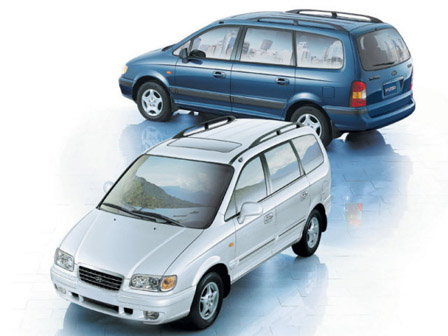 In the design of Trajet, you can see many solutions previously used in Scenic, Galaxy, Zafirze and Sharanie.
In the design of Trajet, you can see many solutions previously used in Scenic, Galaxy, Zafirze and Sharanie.
The Trajet body maintains a two-box silhouette, it is distinguished by a calm "timeless" line. The car is longer (4695 mm) and higher (1710 mm), but narrower (1565 mm) from Zafiry, on which its construction was modeled. The Trajet, on the other hand, has a much longer wheelbase (2830 mm). As in the Zafira, comfortable individual seats are arranged in three rows (2+3+2). By deciding on such an interior design solution, its "flexibility" and multi-variant character were ensured. They can be shaped as follows:
♦ 7 passenger seats (2+3+2) and a luggage compartment with a capacity of. 180 dm3 behind the last row of seats,
♦ 5 passenger seats (2+3) and increased to approx. 500 dm3 luggage compartment with the last row of seats folded down (tilt the backrests and fold the seats forward along the front edge),
♦ 2 passenger seats and increased to over 1800 dm3 luggage compartment with complete removal of center and rear seats.
In addition, thanks to the possibility of rotating the front seats by 180 °, after folding the center seat backrests, it is possible to create a place "around the table" for four people. By properly shifting and unfolding the front and center seats, comfortable sleeping places for two, even tall people, are obtained. Fold down the backrests of the right rear and center seats to create space, enabling the transport of several pairs of skis and snowboards, without compromising ride comfort 5 people.
The driver and passenger seats have folding armrests on the inside, and the driver's seat electric seat height adjustment in the range 30 mm. Comfortable access to the center and rear seats is provided by wide side doors, a high-lift rear door, the pattern extends below the floor, make it easier to move luggage. The load from sliding backwards is prevented by a special net, which is fastened between the housings of the rear wheel arches, in which there are also additional lockable compartments.
There are many handy storage compartments in the passenger compartment. The rear walls of the front seats are equipped with specially shaped folding shelves with openings for cups.
Ergonomically shaped, functional instrument panel, equipped with two airbags – for a driver with a capacity. 65 dm3 and passenger 195 dm3, and six vents for heating the front of the interior (the central and rear sections are heated by air vents under the rear side windows) and quick removal of dew on the windshield and side windows. All side doors have special reinforcements (high-strength steel beams), protecting passengers against the effects of side collisions, on the other hand, the elongated front of the car, in addition to the energy-absorbing bumper, has an energy-consuming zone with an additional support frame, to which the engine is attached.
Standard equipment of the car includes: four-channel ABS, large diameter cooled disc brakes front and rear (as an option), power steering, modern headlamp assembly, fog lamps, automatically activated rain-sensing wipers, rear window wiper, electric door windows and electric door mirrors, central locking with alarm, sunroof and roof rails. Trajeta was also equipped with a radio with a player and a set of four speakers.
Two gasoline engines are provided for the Trajet drive: already known 4-cylinder, 16-valve DOHC with a capacity. 2,0 dm3 and power 103 kW multi-point fuel injection controlled by a 16-bit computer and a completely new 24-valve DOHC V6 engine with a capacity of. 2,7 dm3 and power 125 kW. Both meet the Euro standard 3 and are linked to a 5-speed mechanically controlled gearbox.
Hyundai direct injection diesel engine with common rail fueling, of a capacity 2,0 dm3 and power 81 kW. Trajet available in two trim levels, GL and GLS (with leather upholstery), in eight body colors on wheels with tires 215/65 R15 with two types of alloy rims.